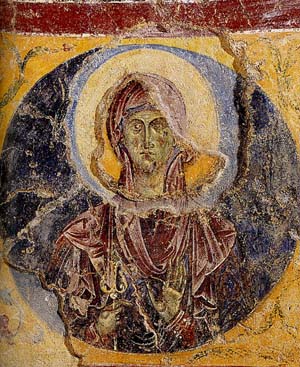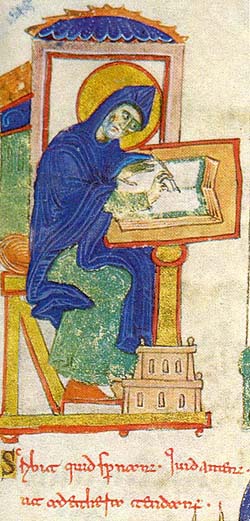 |
The Saint of the Day
St. Scholastica – February 10
Prof. Plinio Corrêa de Oliveira
Biographical selection:
St. Gregory tells us that St. Scholastica was the sister of St. Benedict, and consecrated herself to God at an early age. Under her brother’s direction, she founded and governed a large community near Monte Casino. She died about the year 543.
Comments of Prof. Plinio:

St. Scholastica
12th century, Chapel of Sant'Anna, Monte Cassino
|
St. Scholastica was the sister of St. Benedict, and she developed a work that was closely linked to his, since she was the foundress of the Benedictine Sisters. In a similar way, St. Clare was linked to the work of St. Francis.
Paul VI made St. Benedict the patron of Europe. The idea of giving Europe one patron and the choice of St. Benedict for that honor corresponds to some of the realities to be explained here.
Geographically speaking, Europe is a peninsula of Asia. This peninsula which, in size, represents only a small part of the world, was nonetheless the theater where the most important events in History took place.
And what was the most important thing that happened in Europe? It was the correspondence of its peoples in times past to the teachings of the Catholic Church. Europe was a continent that was to a large extent faithful to the Catholic Church. From this came the establishing of Christian Civilization, which means that the temporal order was saturated with the supernatural energies of grace received through the Catholic Church.
This is the way things work: Only the Catholic Church teaches the true Morals, and only the Catholic Church gives men the necessary strength to practice the true Morals by means of the Sacraments. Now, it is only through this Morals that order can be established in human society. Therefore, perfect order only exists where the Catholic Church exists and is accepted. Only the Catholic Church is, therefore, the foundation of true order.
The social order can be compared in some ways to the human body. If everything is in order, the body works well and one can expect a good response from its movements, reactions, defense system, etc. But if something is wrong – a small bone in the wrist that is out of place – it causes pain, poor responses, inflammation, the danger of gangrene – all kinds of disturbances.
So it is with civilization. If as a whole it is based on Catholic Morals, one can expect all kinds of good from it, even in its details. But when it moves away from Catholic Civilization, even in details that can seem insignificant one can expect all kinds of misery and evils.

St. Benedict established monasteries throughout Europe that spread Catholic Morals and the Catholic mentality
|
Now then, St. Benedict, through his monks, was par excellence the missionary who brought Christian Civilization to the German barbarians. On one hand, he gave a great impulse to the evangelization that conquered the peoples of Western and Central Europe, as well as those of the Scandinavian Peninsula and Eastern Europe.
On the other hand, he established a network of monasteries throughout Europe that spread Catholic Morals and the Catholic mentality. Because of this, a new world was born out of the barbarian invasions. Grace penetrated the roots of the social tree and gave the marvelous fruit that was Europe. And for a long time Europe realized the ideals of the Counter-Revolution. We turn toward that Europe with eyes filled with nostalgia, admiration and affection. The Revolution reared up to destroy that Catholic Europe.
At the base of everything good in European Civilization, we find St. Benedict, and by the merits of her prayers and contemplation, St. Scholastica.
St. Scholastica founded an order of religious who were not turned to social work, nor to teaching Catechism. They did not do any useful work according to the modern mentality. However, they did a thing that was much more important. They prayed and they sacrificed themselves. By their example, they sent this message: If the apostolate of the masculine branch was so fecund, it was because there was a feminine branch that prayed, contemplated and offered sacrifices. This was the role of the feminine branch.
Then we can see the extraordinary, irreplaceable and incomparable role of St. Scholastica. We can find a few willing to act, fewer yet willing to fight, but there is only a small handful willing to suffer. I do not have words enough to express my admiration for the apostolate of those who suffer – for those who accept their crosses, and even more, who ask for the crosses of others and ask to suffer in order to make the apostolate of others fecund. One of the themes that most raises my admiration and my veneration is the fecundity of the apostolate of suffering.
Nothing can be more glorious than someone who takes upon himself suffering, who offers his happiness and fortune in order to give the victory to another. Only God knows this hero.
This is how I see the life of St. Scholastica, a life that should be spoken of with great veneration.


  |
|
Prof. Plinio Corrêa de Oliveira |
The Saint of the Day features highlights from the lives of saints based on comments made by the late Prof. Plinio Corrêa de Oliveira. Following the example of St. John Bosco who used to make similar talks for the boys of his College, each evening it was Prof. Plinio’s custom to make a short commentary on the lives of the next day’s saint in a meeting for youth in order to encourage them in the practice of virtue and love for the Catholic Church. TIA thought that its readers could profit from these valuable commentaries.
The texts of both the biographical data and the comments come from personal notes taken by Atila S. Guimarães from 1964 to 1995. Given the fact that the source is a personal notebook, it is possible that at times the biographic notes transcribed here will not rigorously follow the original text read by Prof. Plinio. The commentaries have also been adapted and translated for TIA’s site.
|
Saint of the Day | Home | Books | CDs | Search | Contact Us | Donate

© 2002- Tradition in Action, Inc. All Rights Reserved
|
 |
|